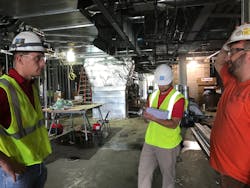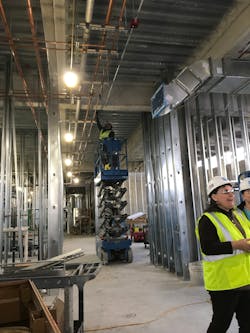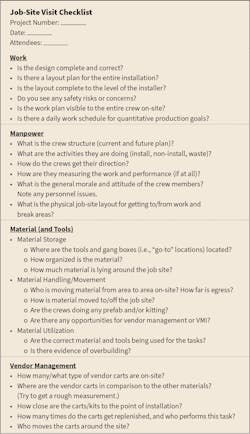The Key to Gathering Job-Site Intelligence
The key to an electrical contractor’s profitability is quickly knowing information on the job site. Although visiting and walking the job site is obviously important, knowing what information you need and how to gather it quickly is even more critical. That is job-site intelligence.
Job-site intelligence means understanding the three Ms: money, manpower, and material. These areas are a constant thread from the beginning of the job to the end. They must be constantly and consistently reviewed, with adjustments made along the life cycle of the job. Only when you’re fast to detect issues and correct them can you keep your team doing what it does best — delivering high-quality installations on time with profitability.
Over the past three decades, through thousands of job-site visits across the country, MCA has identified some key items to help turn your routine “job-site visit” into a gold mine of data and information. These key performance characteristics reveal a project’s current health and future wealth.
Do your prep work
Your first task is to understand where the job stands today — in other words, know the answers to the following questions before you step foot on-site:
- How much material has been ordered, and how does it compare to the estimate?
- What is the current manpower level on-site and the weekly burn rate?
- What is the financial status of the job?
- When is the last time you’ve heard or touched base with your customer or other trade managers on-site?
Review feedback from the field:
- When is the last time you received an update from the team that knows the most?
- What obstacles have they faced?
- Have you been able to support your team in overcoming these challenges?
Before you go:
- Do you know what the crew has on their plan for today? How about yesterday and tomorrow?
- Are you on track with your scheduled deadline, or have you fallen behind schedule?
To accurately compare what you’re looking at when you go, you need to know what you expect to see.
Have a game plan
It’s best to show up on the job site with a checklist (see Table below) so you can easily review the three Ms. Here are some thought starters for the visit.
Use technology
While it’s great to be on the job site to see firsthand the items listed in the checklist, you can also use software tools to tell you how the job is going when you’re not there. It is important to break a large job down into manageable and measurable tasks, ensure the team has a daily plan, and assess that the daily plan is getting done in a timely manner.
Scheduling your team’s work and recognizing and measuring distractions is key to adapting and improving before it’s too late. It is even better when you can use the intelligence across your jobs to do lessons learned in real-time. Take your tablet with you to compare to the drawings. Take pictures of the job site, and share them with your vendors and crew. Document what you see for immediate discussion both on the job site and with the office as needed.
Going beyond basic data gathering and turning what you’ve learned into action items will give your company a competitive edge. You’ll become more efficient by reacting in real time to the challenges, which enables you to be more productive and profitable.
Dr. Moore is vice president of operations and Daneshgari is vice president of financial services for MCA, Inc., Grand Blanc, Mich. They can be reached at [email protected] and [email protected].
Author’s Note: Special thanks to Sonja Daneshgari, manager of field operations, MCA, Inc., and Deanna O’Dell, technical assistant to the vice president of operations, MCA, Inc., for additional contributions on this article.



